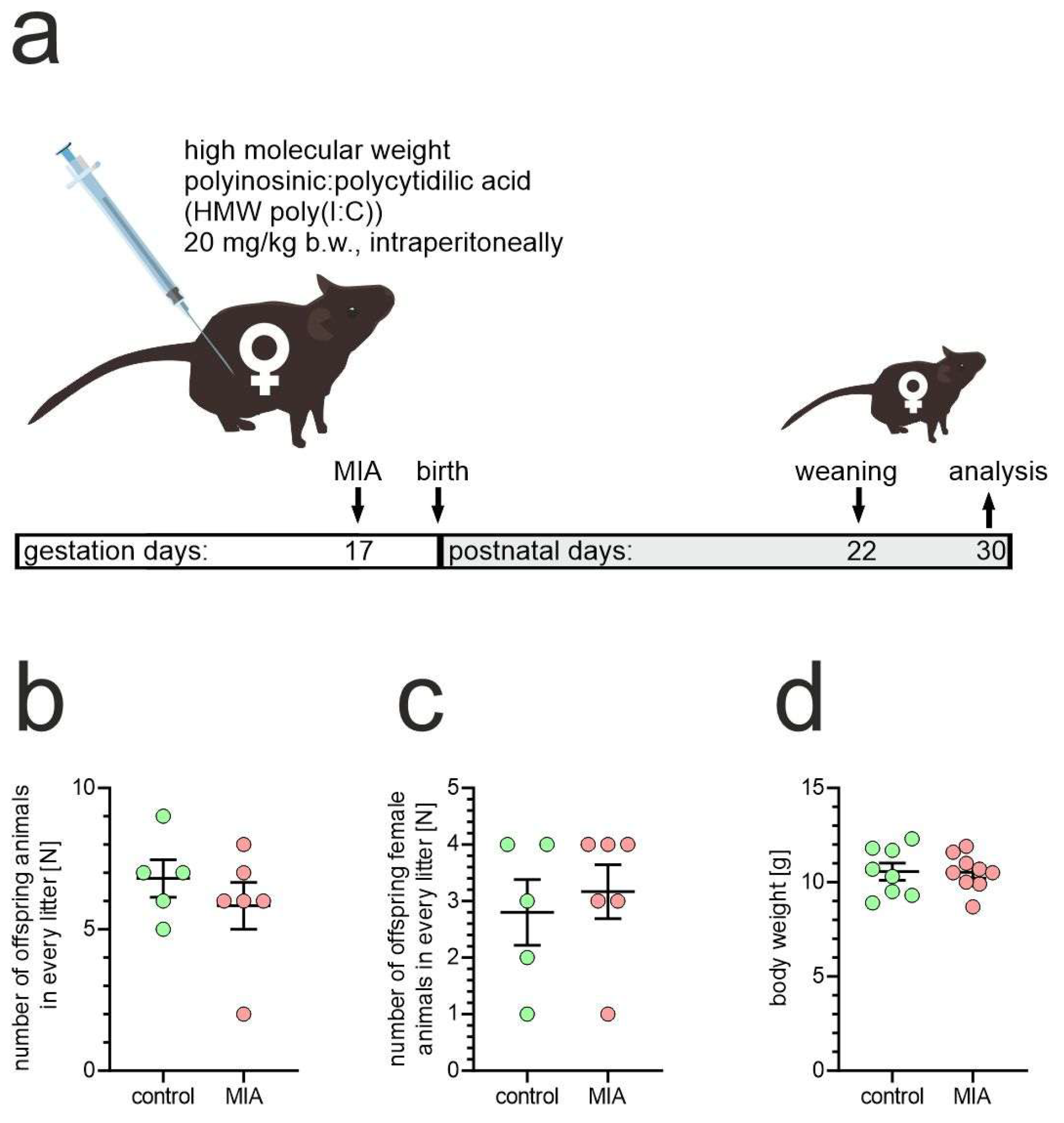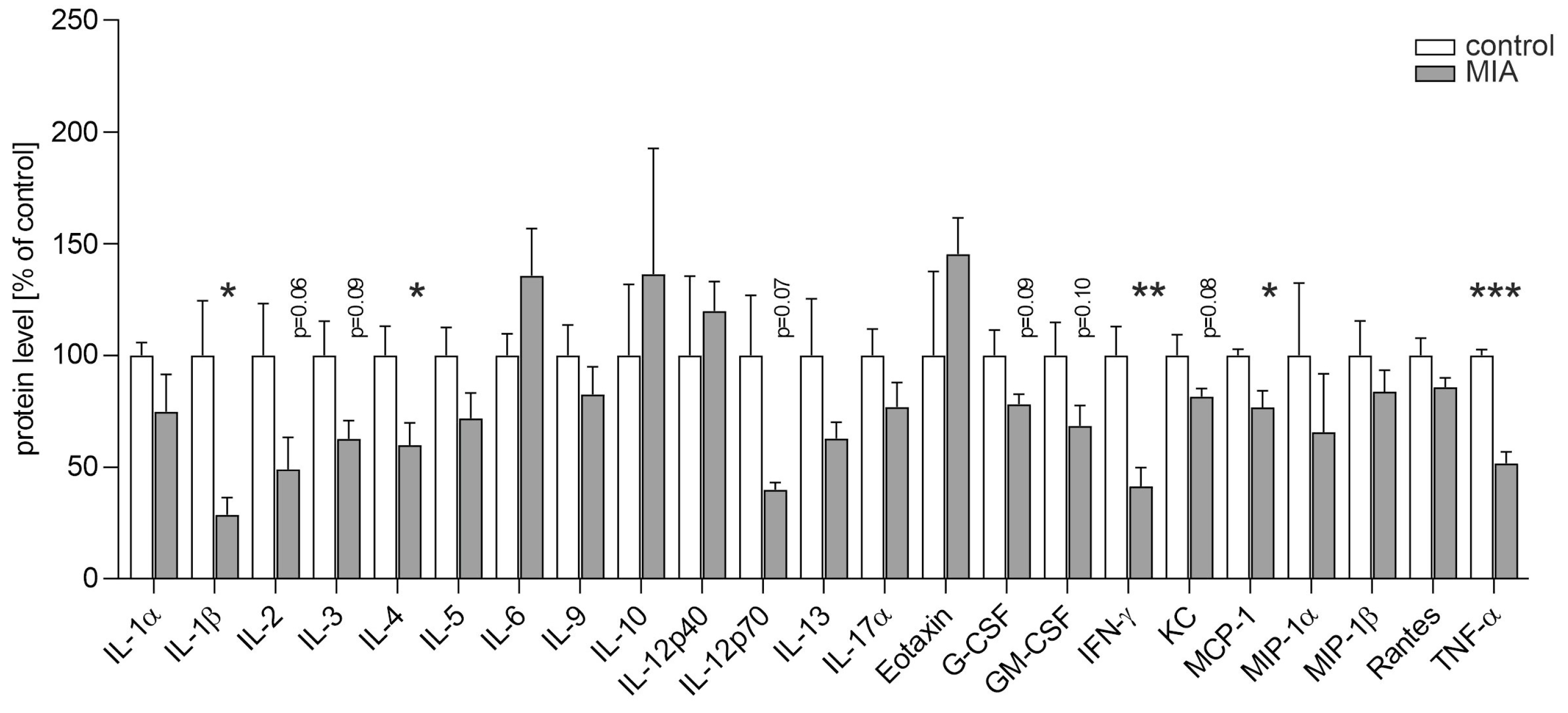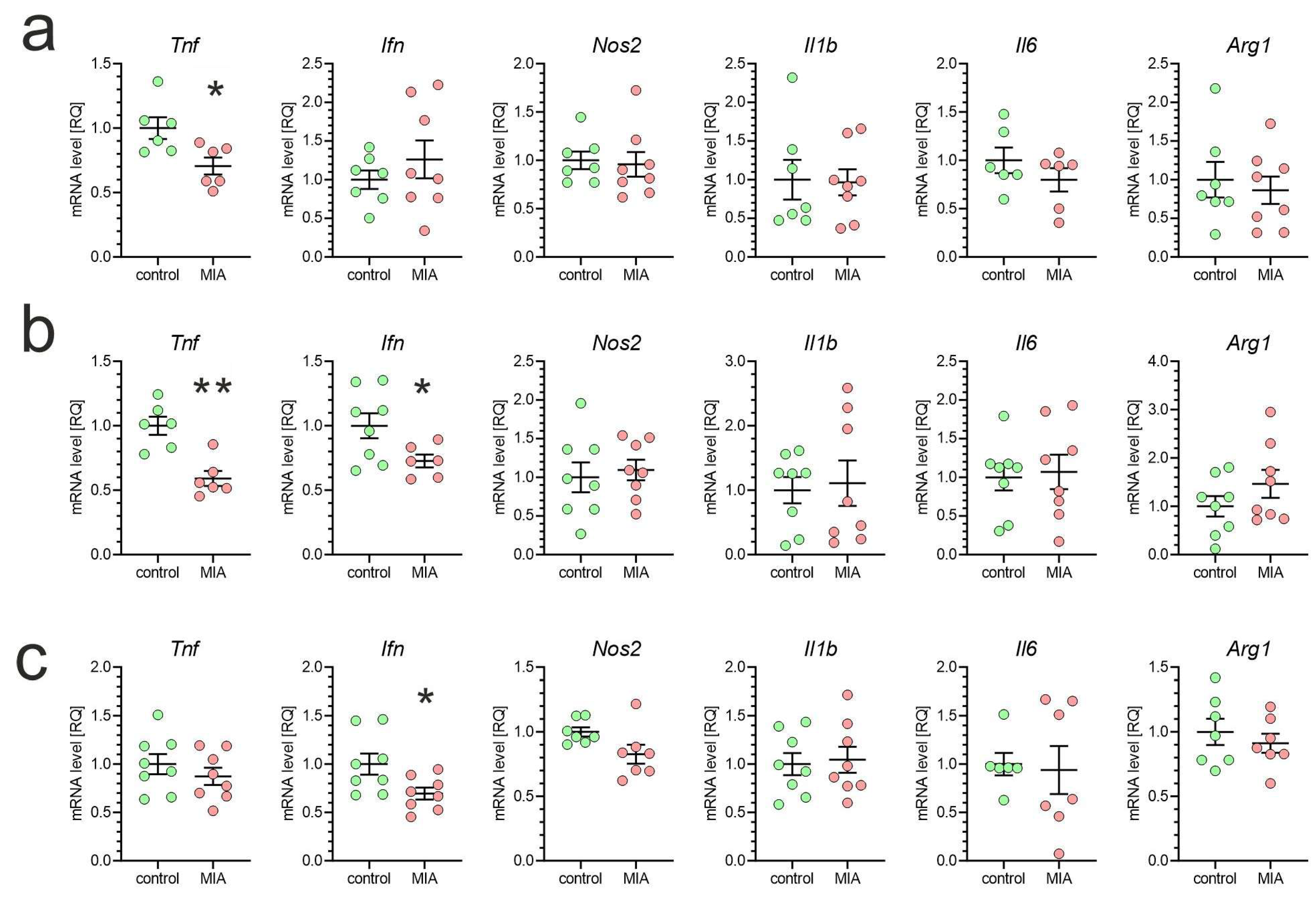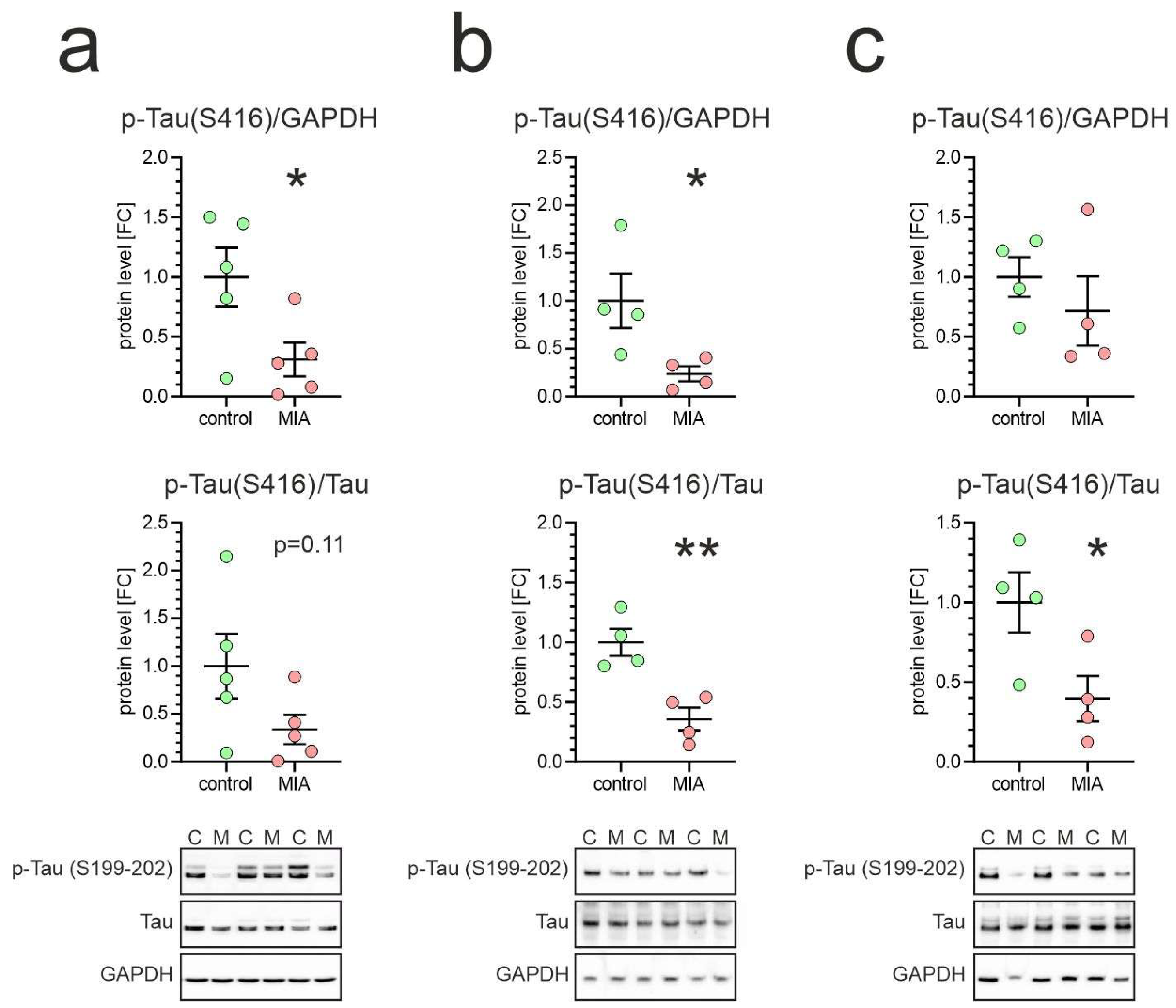Tau Hypophosphorylation at Ser416 as the Early Molecular Imprint of Maternal Immune Activation: Insights from Female Mice Offspring
Abstract
1. Introduction
2. Results
3. Discussion
4. Materials and Methods
4.1. Materials
4.2. Animals
4.3. Experimental Design
4.4. Analysis of Serum Cytokine Levels
4.5. Western Immunoblotting
4.6. Analysis of the mRNA Level
4.7. Statistical Analysis
5. Conclusions
Author Contributions
Funding
Institutional Review Board Statement
Informed Consent Statement
Data Availability Statement
Conflicts of Interest
Abbreviations
| ASD | Autism spectrum disorder |
| AD | Alzheimer’s disease |
| BSA | bovine serum albumin |
| HMW | High molecular weight |
| LPS | lipopolysaccharide |
| MIA | maternal immune activation |
| MT | microtubule |
| poly(I:C) | polyinosinic-polycytidylic acid |
| PND | postnatal day |
| PSD | postsynaptic density |
| TSC | tuberous sclerosis complex |
| VPA | valproic acid |
References
- Khan, S.S.; Bloom, G.S. Tau: The Center of a Signaling Nexus in Alzheimer’s Disease. Front. Neurosci. 2016, 10, 31. [Google Scholar] [CrossRef]
- Biundo, F.; Del Prete, D.; Zhang, H.; Arancio, O.; D’Adamio, L. A Role for Tau in Learning, Memory and Synaptic Plasticity. Sci. Rep. 2018, 8, 3184. [Google Scholar] [CrossRef]
- Robbins, M.; Clayton, E.; Kaminski Schierle, G.S. Synaptic Tau: A Pathological or Physiological Phenomenon? Acta Neuropathol. Commun. 2021, 9, 149. [Google Scholar] [CrossRef] [PubMed]
- Liu, Z.; Qiu, A.-W.; Huang, Y.; Yang, Y.; Chen, J.-N.; Gu, T.-T.; Cao, B.-B.; Qiu, Y.-H.; Peng, Y.-P. IL-17A Exacerbates Neuroinflammation and Neurodegeneration by Activating Microglia in Rodent Models of Parkinson’s Disease. Brain Behav. Immun. 2019, 81, 630–645. [Google Scholar] [CrossRef]
- Wang, Q.; Tao, S.; Xing, L.; Liu, J.; Xu, C.; Xu, X.; Ding, H.; Shen, Q.; Yu, X.; Zheng, Y. SNAP25 Is a Potential Target for Early Stage Alzheimer’s Disease and Parkinson’s Disease. Eur. J. Med. Res. 2023, 28, 570. [Google Scholar] [CrossRef]
- Margiotta, A. Role of SNAREs in Neurodegenerative Diseases. Cells 2021, 10, 991. [Google Scholar] [CrossRef]
- Zhou, L.; McInnes, J.; Wierda, K.; Holt, M.; Herrmann, A.G.; Jackson, R.J.; Wang, Y.-C.; Swerts, J.; Beyens, J.; Miskiewicz, K.; et al. Tau Association with Synaptic Vesicles Causes Presynaptic Dysfunction. Nat. Commun. 2017, 8, 15295. [Google Scholar] [CrossRef]
- Longfield, S.F.; Mollazade, M.; Wallis, T.P.; Gormal, R.S.; Joensuu, M.; Wark, J.R.; van Waardenberg, A.J.; Small, C.; Graham, M.E.; Meunier, F.A.; et al. Tau Forms Synaptic Nano-Biomolecular Condensates Controlling the Dynamic Clustering of Recycling Synaptic Vesicles. Nat. Commun. 2023, 14, 7277. [Google Scholar] [CrossRef]
- Landry, O.; François, A.; Oye Mintsa Mi-Mba, M.-F.; Traversy, M.-T.; Tremblay, C.; Emond, V.; Bennett, D.A.; Gylys, K.H.; Buxbaum, J.D.; Calon, F. Postsynaptic Protein Shank3a Deficiency Synergizes with Alzheimer’s Disease Neuropathology to Impair Cognitive Performance in the 3xTg-AD Murine Model. J. Neurosci. 2023, 43, 4941–4954. [Google Scholar] [CrossRef]
- Wan, L.; Liu, D.; Xiao, W.-B.; Zhang, B.-X.; Yan, X.-X.; Luo, Z.-H.; Xiao, B. Association of SHANK Family with Neuropsychiatric Disorders: An Update on Genetic and Animal Model Discoveries. Cell Mol. Neurobiol. 2022, 42, 1623–1643. [Google Scholar] [CrossRef]
- Smith, S.E.P.; Li, J.; Garbett, K.; Mirnics, K.; Patterson, P.H. Maternal Immune Activation Alters Fetal Brain Development through Interleukin-6. J. Neurosci. 2007, 27, 10695–10702. [Google Scholar] [CrossRef]
- Barón-Mendoza, I.; García, O.; Calvo-Ochoa, E.; Rebollar-García, J.O.; Garzón-Cortés, D.; Haro, R.; González-Arenas, A. Alterations in Neuronal Cytoskeletal and Astrocytic Proteins Content in the Brain of the Autistic-like Mouse Strain C58/J. Neurosci. Lett. 2018, 682, 32–38. [Google Scholar] [CrossRef] [PubMed]
- Tai, C.; Chang, C.-W.; Yu, G.-Q.; Lopez, I.; Yu, X.; Wang, X.; Guo, W.; Mucke, L. Tau Reduction Prevents Key Features of Autism in Mouse Models. Neuron 2020, 106, 421–437.e11. [Google Scholar] [CrossRef] [PubMed]
- Arsenault, D.; St-Amour, I.; Cisbani, G.; Rousseau, L.-S.; Cicchetti, F. The Different Effects of LPS and Poly I:C Prenatal Immune Challenges on the Behavior, Development and Inflammatory Responses in Pregnant Mice and Their Offspring. Brain Behav. Immun. 2014, 38, 77–90. [Google Scholar] [CrossRef] [PubMed]
- Bao, M.; Hofsink, N.; Plösch, T. LPS versus Poly I:C Model: Comparison of Long-Term Effects of Bacterial and Viral Maternal Immune Activation on the Offspring. Am. J. Physiol.-Regul. Integr. Comp. Physiol. 2022, 322, R99–R111. [Google Scholar] [CrossRef]
- Kato, H.; Takeuchi, O.; Mikamo-Satoh, E.; Hirai, R.; Kawai, T.; Matsushita, K.; Hiiragi, A.; Dermody, T.S.; Fujita, T.; Akira, S. Length-Dependent Recognition of Double-Stranded Ribonucleic Acids by Retinoic Acid-Inducible Gene-I and Melanoma Differentiation-Associated Gene 5. J. Exp. Med. 2008, 205, 1601–1610. [Google Scholar] [CrossRef]
- Botos, I.; Liu, L.; Wang, Y.; Segal, D.M.; Davies, D.R. The Toll-like Receptor 3:dsRNA Signaling Complex. Biochim. Biophys. Acta 2009, 1789, 667–674. [Google Scholar] [CrossRef]
- Zhou, Y.; Guo, M.; Wang, X.; Li, J.; Wang, Y.; Ye, L.; Dai, M.; Zhou, L.; Persidsky, Y.; Ho, W. TLR3 Activation Efficiency by High or Low Molecular Mass Poly I:C. Innate. Immun. 2013, 19, 184–192. [Google Scholar] [CrossRef]
- Garay, P.A.; Hsiao, E.Y.; Patterson, P.H.; McAllister, A.K. Maternal Immune Activation Causes Age- and Region-Specific Changes in Brain Cytokines in Offspring throughout Development. Brain Behav. Immun. 2013, 31, 54–68. [Google Scholar] [CrossRef]
- Mousa, A.; Bakhiet, M. Role of Cytokine Signaling during Nervous System Development. Int. J. Mol. Sci. 2013, 14, 13931–13957. [Google Scholar] [CrossRef]
- Hama, T.; Miyamoto, M.; Tsukui, H.; Nishio, C.; Hatanaka, H. Interleukin-6 as a Neurotrophic Factor for Promoting the Survival of Cultured Basal Forebrain Cholinergic Neurons from Postnatal Rats. Neurosci. Lett. 1989, 104, 340–344. [Google Scholar] [CrossRef]
- Akaneya, Y.; Takahashi, M.; Hatanaka, H. Interleukin-1 Beta Enhances Survival and Interleukin-6 Protects against MPP+ Neurotoxicity in Cultures of Fetal Rat Dopaminergic Neurons. Exp. Neurol. 1995, 136, 44–52. [Google Scholar] [CrossRef] [PubMed]
- Gonzalez Caldito, N. Role of Tumor Necrosis Factor-Alpha in the Central Nervous System: A Focus on Autoimmune Disorders. Front. Immunol. 2023, 14, 1213448. [Google Scholar] [CrossRef] [PubMed]
- Baker, C.A.; Iwasaki, A. Beyond Antiviral: Role of IFN-I in Brain Development. Trends Immunol. 2024, 45, 322–324. [Google Scholar] [CrossRef]
- Monje, M.L.; Toda, H.; Palmer, T.D. Inflammatory Blockade Restores Adult Hippocampal Neurogenesis. Science 2003, 302, 1760–1765. [Google Scholar] [CrossRef]
- Nakanishi, M.; Niidome, T.; Matsuda, S.; Akaike, A.; Kihara, T.; Sugimoto, H. Microglia-Derived Interleukin-6 and Leukaemia Inhibitory Factor Promote Astrocytic Differentiation of Neural Stem/Progenitor Cells. Eur. J. Neurosci. 2007, 25, 649–658. [Google Scholar] [CrossRef]
- Cieślik, M.; Gąssowska-Dobrowolska, M.; Jęśko, H.; Czapski, G.A.; Wilkaniec, A.; Zawadzka, A.; Dominiak, A.; Polowy, R.; Filipkowski, R.K.; Boguszewski, P.M.; et al. Maternal Immune Activation Induces Neuroinflammation and Cortical Synaptic Deficits in the Adolescent Rat Offspring. Int. J. Mol. Sci. 2020, 21, 4097. [Google Scholar] [CrossRef]
- Goines, P.E.; Croen, L.A.; Braunschweig, D.; Yoshida, C.K.; Grether, J.; Hansen, R.; Kharrazi, M.; Ashwood, P.; Van de Water, J. Increased Midgestational IFN-γ, IL-4 and IL-5 in Women Bearing a Child with Autism: A Case-Control Study. Mol. Autism 2011, 2, 13. [Google Scholar] [CrossRef]
- Brynge, M.; Gardner, R.M.; Sjöqvist, H.; Lee, B.K.; Dalman, C.; Karlsson, H. Maternal Levels of Cytokines in Early Pregnancy and Risk of Autism Spectrum Disorders in Offspring. Front. Public Health 2022, 10, 917563. [Google Scholar] [CrossRef]
- Allswede, D.M.; Yolken, R.H.; Buka, S.L.; Cannon, T.D. Cytokine Levels throughout Pregnancy and Risk for Psychosis in Adult Offspring: A Case-Control Study. Lancet Psychiatry 2020, 7, 254–261. [Google Scholar] [CrossRef]
- Cieślik, M.; Gassowska-Dobrowolska, M.; Zawadzka, A.; Frontczak-Baniewicz, M.; Gewartowska, M.; Dominiak, A.; Czapski, G.A.; Adamczyk, A. The Synaptic Dysregulation in Adolescent Rats Exposed to Maternal Immune Activation. Front. Mol. Neurosci. 2020, 13, 555290. [Google Scholar] [CrossRef] [PubMed]
- Wang, Y.; Mandelkow, E. Tau in Physiology and Pathology. Nat. Rev. Neurosci. 2016, 17, 5–21. [Google Scholar] [CrossRef] [PubMed]
- Estes, M.L.; McAllister, A.K. Maternal Immune Activation: Implications for Neuropsychiatric Disorders. Science 2016, 353, 772–777. [Google Scholar] [CrossRef] [PubMed]
- Meyer, U. Neurodevelopmental Resilience and Susceptibility to Maternal Immune Activation. Trends Neurosci. 2019, 42, 793–806. [Google Scholar] [CrossRef]
- Maphis, N.; Xu, G.; Kokiko-Cochran, O.N.; Jiang, S.; Cardona, A.; Ransohoff, R.M.; Lamb, B.T.; Bhaskar, K. Reactive Microglia Drive Tau Pathology and Contribute to the Spreading of Pathological Tau in the Brain. Brain 2015, 138, 1738–1755. [Google Scholar] [CrossRef]
- Sal-Sarria, S.; Conejo, N.M.; González-Pardo, H. Maternal Immune Activation and Its Multifaceted Effects on Learning and Memory in Rodent Offspring: A Systematic Review. Neurosci. Biobehav. Rev. 2024, 164, 105844. [Google Scholar] [CrossRef]
- Xu, J.; Zhao, R.; Yan, M.; Zhou, M.; Liu, H.; Wang, X.; Lu, C.; Li, Q.; Mo, Y.; Zhang, P.; et al. Sex-Specific Behavioral and Molecular Responses to Maternal Lipopolysaccharide-Induced Immune Activation in a Murine Model: Implications for Neurodevelopmental Disorders. Int. J. Mol. Sci. 2024, 25, 9885. [Google Scholar] [CrossRef]
- Liu, Y.; Hang, X.; Zhang, Y.; Fang, Y.; Yuan, S.; Zhang, Y.; Wu, B.; Kong, Y.; Kuang, Z.; Sun, W. Maternal Immune Activation Induces Sex-Dependent Behavioral Differences in a Rat Model of Schizophrenia. Front. Psychiatry 2024, 15, 1375999. [Google Scholar] [CrossRef]
- Matuszewska, M.; Wilkaniec, A.; Gąssowska-Dobrowolska, M.; Cieślik, M.; Olech-Kochańczyk, G.; Pałasz, E.; Gawinek, E.; Strawski, M.; Czapski, G.A. Inhibition of BET Proteins Modulates Amyloid-Beta Accumulation and Cognitive Performance in Middle-Aged Mice Prenatally Exposed to Maternal Immune Activation. Front. Mol. Neurosci. 2025, 18, 1619583. [Google Scholar] [CrossRef]
- Brown, A.M.; Conn, I.; Boerrigter, D.; Shannon Weickert, C.; Purves-Tyson, T.D. Maternal Immune Activation with High Molecular Weight Poly(I:C) in Wistar Rats Leads to Elevated Immune Cell Chemoattractants. J. Neuroimmunol. 2022, 364, 577813. [Google Scholar] [CrossRef]
- Ozaki, K.; Kato, D.; Ikegami, A.; Hashimoto, A.; Sugio, S.; Guo, Z.; Shibushita, M.; Tatematsu, T.; Haruwaka, K.; Moorhouse, A.J.; et al. Maternal Immune Activation Induces Sustained Changes in Fetal Microglia Motility. Sci. Rep. 2020, 10, 21378. [Google Scholar] [CrossRef] [PubMed]
- Rose, D.R.; Careaga, M.; Van de Water, J.; McAllister, K.; Bauman, M.D.; Ashwood, P. Long-Term Altered Immune Responses Following Fetal Priming in a Non-Human Primate Model of Maternal Immune Activation. Brain Behav. Immun. 2017, 63, 60–70. [Google Scholar] [CrossRef] [PubMed]
- Onore, C.E.; Schwartzer, J.J.; Careaga, M.; Berman, R.F.; Ashwood, P. Maternal Immune Activation Leads to Activated Inflammatory Macrophages in Offspring. Brain Behav. Immun. 2014, 38, 220–226. [Google Scholar] [CrossRef] [PubMed]
- Fiock, K.L.; Smalley, M.E.; Crary, J.F.; Pasca, A.M.; Hefti, M.M. Increased Tau Expression Correlates with Neuronal Maturation in the Developing Human Cerebral Cortex. eNeuro 2020, 7, ENEURO.0058-20.2020. [Google Scholar] [CrossRef]
- Sapir, T.; Frotscher, M.; Levy, T.; Mandelkow, E.-M.; Reiner, O. Tau’s Role in the Developing Brain: Implications for Intellectual Disability. Hum. Mol. Genet. 2012, 21, 1681–1692. [Google Scholar] [CrossRef]
- Xia, Y.; Prokop, S.; Giasson, B.I. “Don’t Phos Over Tau”: Recent Developments in Clinical Biomarkers and Therapies Targeting Tau Phosphorylation in Alzheimer’s Disease and Other Tauopathies. Mol. Neurodegener. 2021, 16, 37. [Google Scholar] [CrossRef]
- Hefti, M.M.; Kim, S.; Bell, A.J.; Betters, R.K.; Fiock, K.L.; Iida, M.A.; Smalley, M.E.; Farrell, K.; Fowkes, M.E.; Crary, J.F. Tau Phosphorylation and Aggregation in the Developing Human Brain. J. Neuropathol. Exp. Neurol. 2019, 78, 930–938. [Google Scholar] [CrossRef]
- Yu, Y.; Run, X.; Liang, Z.; Li, Y.; Liu, F.; Liu, Y.; Iqbal, K.; Grundke-Iqbal, I.; Gong, C.-X. Developmental Regulation of Tau Phosphorylation, Tau Kinases, and Tau Phosphatases. J. Neurochem. 2009, 108, 1480–1494. [Google Scholar] [CrossRef]
- Yamamoto, H.; Hiragami, Y.; Murayama, M.; Ishizuka, K.; Kawahara, M.; Takashima, A. Phosphorylation of Tau at Serine 416 by Ca2+/Calmodulin-Dependent Protein Kinase II in Neuronal Soma in Brain. J. Neurochem. 2005, 94, 1438–1447. [Google Scholar] [CrossRef]
- Wiegersma, A.M.; Boots, A.; Langendam, M.W.; Limpens, J.; Shenkin, S.D.; Korosi, A.; Roseboom, T.J.; de Rooij, S.R. Do Prenatal Factors Shape the Risk for Dementia?: A Systematic Review of the Epidemiological Evidence for the Prenatal Origins of Dementia. Soc. Psychiatry Psychiatr. Epidemiol. 2025, 60, 977–991. [Google Scholar] [CrossRef]
- Minakova, E.; Warner, B.B. Maternal Immune Activation, Central Nervous System Development and Behavioral Phenotypes. Birth Defects Res. 2018, 110, 1539–1550. [Google Scholar] [CrossRef]
- Knuesel, I.; Chicha, L.; Britschgi, M.; Schobel, S.A.; Bodmer, M.; Hellings, J.A.; Toovey, S.; Prinssen, E.P. Maternal Immune Activation and Abnormal Brain Development across CNS Disorders. Nat. Rev. Neurol. 2014, 10, 643–660. [Google Scholar] [CrossRef]
- Kentner, A.C.; Bilbo, S.D.; Brown, A.S.; Hsiao, E.Y.; McAllister, A.K.; Meyer, U.; Pearce, B.D.; Pletnikov, M.V.; Yolken, R.H.; Bauman, M.D. Maternal Immune Activation: Reporting Guidelines to Improve the Rigor, Reproducibility, and Transparency of the Model. Neuropsychopharmacology 2019, 44, 245–258. [Google Scholar] [CrossRef]
- Beery, A.K.; Zucker, I. Sex Bias in Neuroscience and Biomedical Research. Neurosci. Biobehav. Rev. 2011, 35, 565–572. [Google Scholar] [CrossRef]
- Goldstein, J.M.; Cohen, J.E.; Mareckova, K.; Holsen, L.; Whitfield-Gabrieli, S.; Gilman, S.E.; Buka, S.L.; Hornig, M. Impact of Prenatal Maternal Cytokine Exposure on Sex Differences in Brain Circuitry Regulating Stress in Offspring 45 Years Later. Proc. Natl. Acad. Sci. USA 2021, 118, e2014464118. [Google Scholar] [CrossRef] [PubMed]
- Osman, H.C.; Moreno, R.; Rose, D.; Rowland, M.E.; Ciernia, A.V.; Ashwood, P. Impact of Maternal Immune Activation and Sex on Placental and Fetal Brain Cytokine and Gene Expression Profiles in a Preclinical Model of Neurodevelopmental Disorders. J. Neuroinflamm. 2024, 21, 118. [Google Scholar] [CrossRef] [PubMed]
- Meyer, U.; Feldon, J.; Schedlowski, M.; Yee, B.K. Immunological Stress at the Maternal–Foetal Interface: A Link between Neurodevelopment and Adult Psychopathology. Brain Behav. Immun. 2006, 20, 378–388. [Google Scholar] [CrossRef] [PubMed]
- Tolstova, T.; Dotsenko, E.; Kozhin, P.; Novikova, S.; Zgoda, V.; Rusanov, A.; Luzgina, N. The Effect of TLR3 Priming Conditions on MSC Immunosuppressive Properties. Stem Cell Res. Ther. 2023, 14, 344. [Google Scholar] [CrossRef]
- Magatti, M.; Stefani, F.R.; Papait, A.; Cargnoni, A.; Masserdotti, A.; Silini, A.R.; Parolini, O. Perinatal Mesenchymal Stromal Cells and Their Possible Contribution to Fetal-Maternal Tolerance. Cells 2019, 8, 1401. [Google Scholar] [CrossRef]
- Abu-Raya, B.; Michalski, C.; Sadarangani, M.; Lavoie, P.M. Maternal Immunological Adaptation During Normal Pregnancy. Front. Immunol. 2020, 11, 575197. [Google Scholar] [CrossRef]
- Abumaree, M.H.; Abomaray, F.M.; Alshabibi, M.A.; AlAskar, A.S.; Kalionis, B. Immunomodulatory Properties of Human Placental Mesenchymal Stem/Stromal Cells. Placenta 2017, 59, 87–95. [Google Scholar] [CrossRef]
- Chen, Y.; Zhuang, Y.; Chen, X.; Huang, L. Effect of Human Endometrial Stromal Cell-Derived Conditioned Medium on Uterine Natural Killer (uNK) Cells’ Proliferation and Cytotoxicity. Am. J. Reprod. Immunol. 2011, 65, 589–596. [Google Scholar] [CrossRef] [PubMed]
- Tsai, P.-J.; Wang, H.-S.; Lin, G.-J.; Chou, S.-C.; Chu, T.-H.; Chuan, W.-T.; Lu, Y.-J.; Weng, Z.-C.; Su, C.-H.; Hsieh, P.-S.; et al. Undifferentiated Wharton’s Jelly Mesenchymal Stem Cell Transplantation Induces Insulin-Producing Cell Differentiation and Suppression of T-Cell-Mediated Autoimmunity in Nonobese Diabetic Mice. Cell Transplant. 2015, 24, 1555–1570. [Google Scholar] [CrossRef] [PubMed]
- Pianta, S.; Magatti, M.; Vertua, E.; Bonassi Signoroni, P.; Muradore, I.; Nuzzo, A.M.; Rolfo, A.; Silini, A.; Quaglia, F.; Todros, T.; et al. Amniotic Mesenchymal Cells from Pre-eclamptic Placentae Maintain Immunomodulatory Features as Healthy Controls. J. Cell Mol. Med. 2016, 20, 157–169. [Google Scholar] [CrossRef] [PubMed]
- Kronsteiner, B.; Peterbauer-Scherb, A.; Grillari-Voglauer, R.; Redl, H.; Gabriel, C.; van Griensven, M.; Wolbank, S. Human Mesenchymal Stem Cells and Renal Tubular Epithelial Cells Differentially Influence Monocyte-Derived Dendritic Cell Differentiation and Maturation. Cell Immunol. 2011, 267, 30–38. [Google Scholar] [CrossRef]
- Rossi, D.; Pianta, S.; Magatti, M.; Sedlmayr, P.; Parolini, O. Characterization of the Conditioned Medium from Amniotic Membrane Cells: Prostaglandins as Key Effectors of Its Immunomodulatory Activity. PLoS ONE 2012, 7, e46956. [Google Scholar] [CrossRef]
- Ayaydın, H.; Kirmit, A.; Çelik, H.; Akaltun, İ.; Koyuncu, İ.; Bilgen Ulgar, Ş. High Serum Levels of Serum 100 Beta Protein, Neuron-Specific Enolase, Tau, Active Caspase-3, M30 and M65 in Children with Autism Spectrum Disorders. Clin. Psychopharmacol. Neurosci. 2020, 18, 270–278. [Google Scholar] [CrossRef]
- Grigg, I.; Ivashko-Pachima, Y.; Hait, T.A.; Korenková, V.; Touloumi, O.; Lagoudaki, R.; Van Dijck, A.; Marusic, Z.; Anicic, M.; Vukovic, J.; et al. Tauopathy in the Young Autistic Brain: Novel Biomarker and Therapeutic Target. Transl. Psychiatry 2020, 10, 228. [Google Scholar] [CrossRef]
- Gąssowska-Dobrowolska, M.; Kolasa-Wołosiuk, A.; Cieślik, M.; Dominiak, A.; Friedland, K.; Adamczyk, A. Alterations in Tau Protein Level and Phosphorylation State in the Brain of the Autistic-Like Rats Induced by Prenatal Exposure to Valproic Acid. Int. J. Mol. Sci. 2021, 22, 3209. [Google Scholar] [CrossRef]
- Gąssowska-Dobrowolska, M.; Kolasa, A.; Beversdorf, D.Q.; Adamczyk, A. Alterations in Cerebellar Microtubule Cytoskeletal Network in a Valproic Acid-Induced Rat Model of Autism Spectrum Disorders. Biomedicines 2022, 10, 3031. [Google Scholar] [CrossRef]
- Gąssowska-Dobrowolska, M.; Czapski, G.A.; Cieślik, M.; Zajdel, K.; Frontczak-Baniewicz, M.; Babiec, L.; Adamczyk, A. Microtubule Cytoskeletal Network Alterations in a Transgenic Model of Tuberous Sclerosis Complex: Relevance to Autism Spectrum Disorders. Int. J. Mol. Sci. 2023, 24, 7303. [Google Scholar] [CrossRef]
- Liu, F.; Li, B.; Tung, E.-J.; Grundke-Iqbal, I.; Iqbal, K.; Gong, C.-X. Site-Specific Effects of Tau Phosphorylation on Its Microtubule Assembly Activity and Self-Aggregation. Eur. J. Neurosci. 2007, 26, 3429–3436. [Google Scholar] [CrossRef] [PubMed]
- Stephenson, J.R.; Wang, X.; Perfitt, T.L.; Parrish, W.P.; Shonesy, B.C.; Marks, C.R.; Mortlock, D.P.; Nakagawa, T.; Sutcliffe, J.S.; Colbran, R.J. A Novel Human CAMK2A Mutation Disrupts Dendritic Morphology and Synaptic Transmission, and Causes ASD-Related Behaviors. J. Neurosci. 2017, 37, 2216–2233. [Google Scholar] [CrossRef] [PubMed]
- Sandal, P.; Jong, C.J.; Merrill, R.A.; Song, J.; Strack, S. Protein Phosphatase 2A—Structure, Function and Role in Neurodevelopmental Disorders. J. Cell Sci. 2021, 134, jcs248187. [Google Scholar] [CrossRef] [PubMed]
- Martín-Guerrero, S.M.; Martín-Estebané, M. Lara Ordóñez, A.J.; Cánovas, M.; Martín-Oliva, D.; González-Maeso, J.; Cutillas, P.R.; López-Giménez, J.F. Maternal immune activation imprints translational dysregulation and differential MAP2 phosphorylation in descendant neural stem cells. Mol. Psychiatry 2025, 30, 2994–3007. [Google Scholar] [CrossRef]
- Jacot-Descombes, S.; Keshav, N.U.; Dickstein, D.L.; Wicinski, B.; Janssen, W.G.M.; Hiester, L.L.; Sarfo, E.K.; Warda, T.; Fam, M.M.; Harony-Nicolas, H.; et al. Altered Synaptic Ultrastructure in the Prefrontal Cortex of Shank3-Deficient Rats. Mol. Autism 2020, 11, 89. [Google Scholar] [CrossRef]
- Berg, E.L.; Jami, S.A.; Petkova, S.P.; Berz, A.; Fenton, T.A.; Lerch, J.P.; Segal, D.J.; Gray, J.A.; Ellegood, J.; Wöhr, M.; et al. Excessive Laughter-like Vocalizations, Microcephaly, and Translational Outcomes in the Ube3a Deletion Rat Model of Angelman Syndrome. J. Neurosci. 2021, 41, 8801–8814. [Google Scholar] [CrossRef]
- Phelan, K.; McDermid, H.E. The 22q13.3 Deletion Syndrome (Phelan-McDermid Syndrome). Mol. Syndromol. 2012, 2, 186–201. [Google Scholar] [CrossRef]
- Vyas, Y.; Cheyne, J.E.; Lee, K.; Jung, Y.; Cheung, P.Y.; Montgomery, J.M. Shankopathies in the Developing Brain in Autism Spectrum Disorders. Front. Neurosci. 2021, 15, 775431. [Google Scholar] [CrossRef]
- Monteiro, P.; Feng, G. SHANK Proteins: Roles at the Synapse and in Autism Spectrum Disorder. Nat. Rev. Neurosci. 2017, 18, 147–157. [Google Scholar] [CrossRef]
- Leblond, C.S.; Nava, C.; Polge, A.; Gauthier, J.; Huguet, G.; Lumbroso, S.; Giuliano, F.; Stordeur, C.; Depienne, C.; Mouzat, K.; et al. Meta-Analysis of SHANK Mutations in Autism Spectrum Disorders: A Gradient of Severity in Cognitive Impairments. PLoS Genet. 2014, 10, e1004580. [Google Scholar] [CrossRef] [PubMed]
- Woelfle, S.; Pedro, M.T.; Wagner, J.; Schön, M.; Boeckers, T.M. Expression Profiles of the Autism-Related SHANK Proteins in the Human Brain. BMC Biol. 2023, 21, 254. [Google Scholar] [CrossRef]
- Berg, E.L.; Copping, N.A.; Rivera, J.K.; Pride, M.C.; Careaga, M.; Bauman, M.D.; Berman, R.F.; Lein, P.J.; Harony-Nicolas, H.; Buxbaum, J.D.; et al. Developmental Social Communication Deficits in the Shank3 Rat Model of Phelan-Mcdermid Syndrome and Autism Spectrum Disorder. Autism Res. 2018, 11, 587–601. [Google Scholar] [CrossRef]
- Atanasova, E.; Arévalo, A.P.; Graf, I.; Zhang, R.; Bockmann, J.; Lutz, A.-K.; Boeckers, T.M. Immune Activation during Pregnancy Exacerbates ASD-Related Alterations in Shank3-Deficient Mice. Mol. Autism 2023, 14, 1. [Google Scholar] [CrossRef]
- Mueller, F.S.; Richetto, J.; Hayes, L.N.; Zambon, A.; Pollak, D.D.; Sawa, A.; Meyer, U.; Weber-Stadlbauer, U. Influence of Poly(I:C) Variability on Thermoregulation, Immune Responses and Pregnancy Outcomes in Mouse Models of Maternal Immune Activation. Brain Behav. Immun. 2019, 80, 406–418. [Google Scholar] [CrossRef]
- Krstic, D.; Madhusudan, A.; Doehner, J.; Vogel, P.; Notter, T.; Imhof, C.; Manalastas, A.; Hilfiker, M.; Pfister, S.; Schwerdel, C.; et al. Systemic Immune Challenges Trigger and Drive Alzheimer-like Neuropathology in Mice. J. Neuroinflamm. 2012, 9, 151. [Google Scholar] [CrossRef]
- Czapski, G.A.; Babiec, L.; Jęśko, H.; Gąssowska-Dobrowolska, M.; Cieślik, M.; Matuszewska, M.; Frontczak-Baniewicz, M.; Zajdel, K.; Adamczyk, A. Synaptic Alterations in a Transgenic Model of Tuberous Sclerosis Complex: Relevance to Autism Spectrum Disorders. Int. J. Mol. Sci. 2021, 22, 10058. [Google Scholar] [CrossRef]








Disclaimer/Publisher’s Note: The statements, opinions and data contained in all publications are solely those of the individual author(s) and contributor(s) and not of MDPI and/or the editor(s). MDPI and/or the editor(s) disclaim responsibility for any injury to people or property resulting from any ideas, methods, instructions or products referred to in the content. |
© 2025 by the authors. Licensee MDPI, Basel, Switzerland. This article is an open access article distributed under the terms and conditions of the Creative Commons Attribution (CC BY) license (https://creativecommons.org/licenses/by/4.0/).
Share and Cite
Bielska, E.; Matuszewska, M.; Wójcik, P.; Wilkaniec, A.; Cieślik, M.; Gąssowska-Dobrowolska, M.; Sulejczak, D.; Czapski, G.A.; Adamczyk, A. Tau Hypophosphorylation at Ser416 as the Early Molecular Imprint of Maternal Immune Activation: Insights from Female Mice Offspring. Int. J. Mol. Sci. 2025, 26, 10778. https://doi.org/10.3390/ijms262110778
Bielska E, Matuszewska M, Wójcik P, Wilkaniec A, Cieślik M, Gąssowska-Dobrowolska M, Sulejczak D, Czapski GA, Adamczyk A. Tau Hypophosphorylation at Ser416 as the Early Molecular Imprint of Maternal Immune Activation: Insights from Female Mice Offspring. International Journal of Molecular Sciences. 2025; 26(21):10778. https://doi.org/10.3390/ijms262110778
Chicago/Turabian StyleBielska, Ewelina, Marta Matuszewska, Piotr Wójcik, Anna Wilkaniec, Magdalena Cieślik, Magdalena Gąssowska-Dobrowolska, Dorota Sulejczak, Grzegorz A. Czapski, and Agata Adamczyk. 2025. "Tau Hypophosphorylation at Ser416 as the Early Molecular Imprint of Maternal Immune Activation: Insights from Female Mice Offspring" International Journal of Molecular Sciences 26, no. 21: 10778. https://doi.org/10.3390/ijms262110778
APA StyleBielska, E., Matuszewska, M., Wójcik, P., Wilkaniec, A., Cieślik, M., Gąssowska-Dobrowolska, M., Sulejczak, D., Czapski, G. A., & Adamczyk, A. (2025). Tau Hypophosphorylation at Ser416 as the Early Molecular Imprint of Maternal Immune Activation: Insights from Female Mice Offspring. International Journal of Molecular Sciences, 26(21), 10778. https://doi.org/10.3390/ijms262110778







